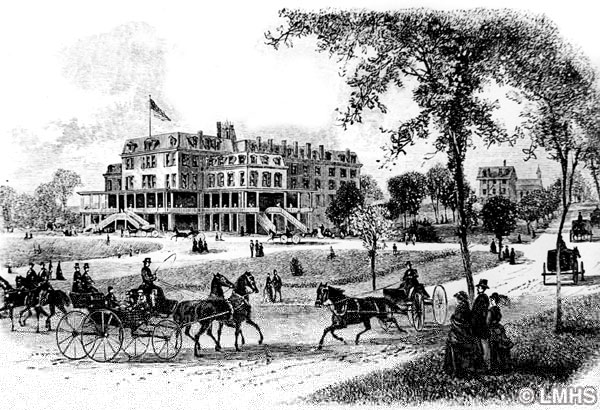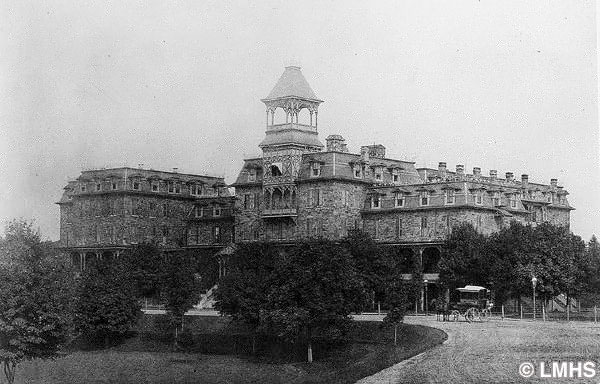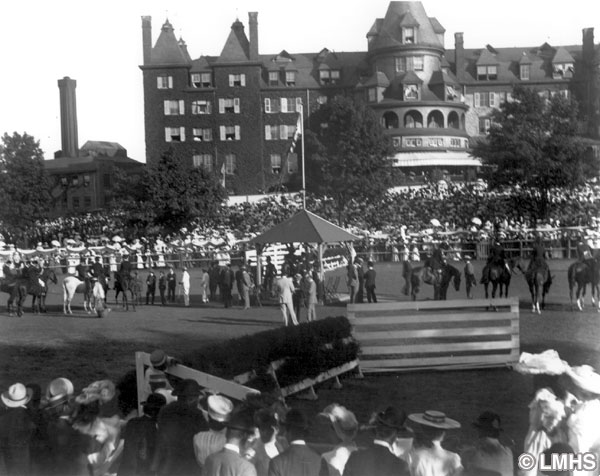The Bryn Mawr Hotel
At the heart of Bryn Mawr was the genteel Bryn Mawr Hotel (or Keystone Hotel, as it was first called), a grand summer resort constructed and operated by the Pennsylvania Railroad Company. Conveniently located in the rural countryside only half a mile from the Bryn Mawr train station, the picturesque resort provided summer fun and social activities to the well heeled from Philadelphia and other cities beyond.
A Careful Plan
The creation of a resort locale, just outside of Philadelphia, was a deliberate move by the railroad’s management to entice riders to use their Main Line passenger service. Toward this end, they purchased an adjoining 25-acre tract in the late 1860s and built an elaborate train station and the resort hotel. The remaining land was subdivided into lots and sold to those desiring to escape the overcrowded, hot, noisy city in favor of the healthier bucolic countryside of Bryn Mawr.
Designed by the Pennsylvania Railroad-favored architect Joseph Miller Wilson, the four story, stone masonry Keystone Hotel building boasted 350 rooms, a very fashionable polychromed slate mansard roof, and a verandah to rival any other resort hotel verandah.
The Keystone first opened its doors for the summer season of 1872. Healthy profits enabled management to construct additions and improvements to the hotel after only its first year. The first few summers were so successful that, after the 1876 Centennial Exhibition, the management determined to keep the hotel open into the winter. Failed attempts to draw enough reservations after September, however, proved that Philadelphia society preferred to winter in the city.


Hotel High Living
Equipped with every convenience and luxury for its guests’ comfort and delight, the Keystone’s amenities included gas light, bathtubs, the first elevator on the Main Line, a “ten pin alley,” first-quality mattresses, and the location of one bathroom on every floor! No expense was spared with the interiors either…the furniture was valued at $75,000 in 1887.
Social life of all Bryn Mawr centered around activities at the Keystone. Both locals and hotel guests eagerly awaited the event of the season, the Bryn Mawr Assemblies, which would draw more than 500 people. Equestrian activities were popular as well as carriage riding and horseback riding. Baseball, tennis, and cricket were also favorites.
The Keystone Hotel would not stand forever. Amidst (and probably because of) declining popularity and a decrease in net profits, the building was suddenly destroyed by fire in October, 1887.
The Resort Rebuilds
Apparently still a promising resort location, Bryn Mawr would soon see another hotel on the same site. The Bryn Mawr Hotel Company, whose board of directors included Philadelphia industry and railroad leaders of the day, was incorporated in 1890 for the sole purpose of constructing a first class hotel. The group commissioned the well connected Philadelphia architectural firm of Furness, Evans and Company to design its new building. Not to be outdone by the fanciful, picturesque architecture of other resorts, the hotel was reportedly inspired by the restored 16th century Chateau de Pierrefonds in France.
The impressive, four story granite structure was built with the latest conveniences, including a hydraulic elevator, the latest in plumbing fixtures, extensive ventilation and drainage systems, a steam heating system, and electric light.
Croquet and golf were popular activities and were played on the expansive front lawn. The first hole of the nine hole golf course was located right in front of the main entrance. Clay tennis courts were located in the rear, directly below the verandah. Balls, dances, fundraisers, and nightly card games provided indoor amusements for the hotel guests in this flambouyant hostelry.
Miss Baldwin’s School
Florence Baldwin brought her Preparatory School for Girls to the Bryn Mawr Hotel in 1896 when she leased the building and one third of the grounds during the fall and winter months to conduct her classes. The hotel continued to operate during the summer months until finally, in 1913, the owners signed a year-round lease with Miss Baldwin for her boarding school. In 1922, the Baldwin School purchased the 25 acre lot. The building still stands today …an architectural treasure from another era.


